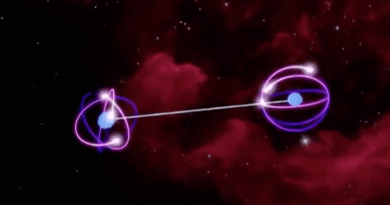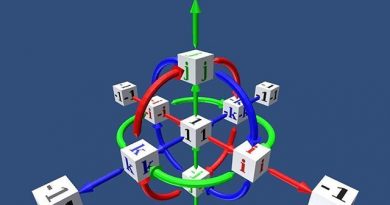Noncommutativity and observer dependence of QM are morally equivalent
Luboš Motl, september 15, 2016
I want to add a playful «research» twist to my explanations of the foundations of quantum mechanics.
In many blog posts, I argued that the need to express the facts about Nature relatively to an observer – the «subjective» character of knowledge – is a defining property of quantum mechanics. Quantum mechanics is the only known consistent framework that makes it impossible to assume (like classical physics did) that all observations may be derived as consequences of some shared objective data (data independent of an observer). This property of quantum mechanics will be referred to as its observer dependence.
However, most recently 2 weeks ago, I also argued that all novelties of quantum mechanics may be reduced to the nonzero commutators. After all, Planck’s constant \(\hbar\) is the constant that is approximated by \(\hbar=0\) in classical physics (or the classical limits of quantum theory) which means that it quantifies the deviations from classical physics. At the same moment, all commutators of observables that exist classically as well as quantum mechanically are proportional to \(\hbar\) in the quantum theory. The nonzero commutators are equivalent to what we will call noncommutativity of quantum mechanics.
OK, these seem like two different «defining» principles of quantum mechanics. Which of them is right? Needless to say, you may say that both principles are right and must be embraced to construct the correct framework. However, I will try to defend a prettier statement. These two principles aren’t really independent. To some extent, they are equivalent!
How it can be? Well, according to classical physics, the truth about everything and anything «objectively exists somewhere». The observer dependence of quantum mechanics means that according to quantum mechanics, the truth about something is only physically meaningful «relatively to an observer who has observed whether it’s true or not».
This statement basically means that
the truth must be lived, not just believed to exist.
Now, this sounds like a sentence from a sermon, a talk by a motivational speaker, or at least a lecture by a philosopher. And I formulated it in that way deliberately. But what I mean by this laymen-style assertion is something rather quantitative.
The truth in quantum mechanics isn’t something that just exists; it’s something that affects an observer and his knowledge. It transforms his life or at least his brain. In other words, the learning of the truth is a transformation.
And it’s the character of the truth as a transformation that is responsible for the non-commuting character of observables in quantum mechanics. I think that these insights are the reason why Dirac has framed the basic insights of quantum mechanics as «Dirac’s transformation theory» up to some moment. The point is that certain objects that had been believed to be \(c\)-numbers of absolute value equal to one – for example \(\exp(i\alpha J_z)\) – were actually \(q\)-numbers i.e. \(U(N)\) transformations of the Hilbert space.
So you know, when an observer learns three true facts, his wave function undergoes three projection by projection operators:
\[ \ket\psi \to P_C P_B P_A \ket\psi. \] All the operators \(P_i\) are Hermitian projection operators,
\[ P_i = P_i^\dagger,\quad (P_i)^2 = P_i. \] The observer first perceives that the proposition associated with the projection operator \(P_A\) was true, then he learns the truth of \(P_B\), and finally of \(P_C\). Just to be sure, the density matrix would be transformed as
\[ \rho \to P_C P_B P_A \,\,\rho\,\, P_A P_B P_C. \] I am allowing an arbitrary normalization of the state vectors and density matrices here. Now, noncommutativity of quantum mechanics means that, for example,
\[ P_A P_B \neq P_B P_A \] Because the projection operators \(P_i\) generalize the truth values of classical bits that are equal either to \(0\) or \(1\), how is it possible that such truth values can refuse to commute in quantum mechanics?
Well, it’s because whenever they don’t commute, only one of the orderings actually corresponds to the observations by the observers. When some regionally localized operators \(P_A,P_B\) don’t commute, it means that they’re timelike- or lightlike-separated. And we can say which of them occurred first. In our example, the observer first detected \(P_A\) and «this truth changed his life» in some way. And then his knowledge and life was changed once again by \(P_B\). And finally by \(P_C\), we said, but that’s not relevant for the commutator \([P_A,P_B]\).
Note that I encourage you to imagine that \(\ket\psi\) or \(\rho\) describe the «state of one’s mind» or «soul» or whatever word you will find acceptable or exciting enough. It’s the same thing.
A nice fact preserving the consistency of this construction is that when the chronology of the events \(P_A,P_B\) isn’t well-defined because they are spacelike-separated, we could be worried that both orderings of the observations might be correct according to various inertial systems. But it’s OK because in that case, the projection operators have to commute! Needless to say, you know this «happy coincidence» as a fact that allows the time-ordering operator \(T\) to remain well-defined in a relativistic theory. But you may frame the same happy news a bit differently, too.
Now, we may use some vague terminology of philosophers of consciousness. Qualia are said to be the units of perceptions. The singular form isn’t a qualium but a quale. Well, let’s respect this ugly word. I won’t reproduce the assumption that each quale has to be «elementary» – because I don’t believe that there is always a unique way to divide perceptions to elementary building blocks.
With this generalization, we may define a quale as follows:
A quale is a Hermitian projection operator.
Our operators \(P_A,P_B,P_C\) were qualia. They decided how the knowledge or the soul – given by the state \(\ket\psi\) or \(\rho\) – was changed. We are supposed to use the qualia so that we only multiply the state by the projection operators that the observer saw to have the eigenvalue \(P_i=1\), i.e. whose corresponding propositions were observed to be true.
When the observer just learns that \(P_A=1\), his density matrix gets transformed as
\[ \rho \to P_A \rho P_A. \] We want to adopt the terminology that this change of \(\rho\) is equivalent to the observer’s having a particular quale (an amount of perception or conscious experience) \(P_A\). Later, the observer may perceive the quale \(P_B\) and so on. Whether he remembers the feeling of \(P_A\) at a later time (and whether he can interpret it to reconstruct the past) depends on his memory and other «technical» things. But the qualia may occur independently of the memory.
Now, I think it’s natural to imagine that each quale is a transformation of your brain, and therefore one of the objects that form an associative
\[ (P_C P_B) P_A = P_C (P_B P_A) = P_C P_B P_A \] but not commutative algebra.
Imagine that your brain consists of very many marbles and every time you observe \(P_C\) which corresponds to \(N\neq 0\) where \(N\) is the number of nuclear blasts in the Visegrád Group during the last hour (I am sure that the PC people agree that such an event is rather \(P_C\) these days), a particular permutation of the marbles in your brain takes place. Whenever you observe the happier quale \(1-P_C\), i.e. the absence of a nuclear blast, another permutation takes place. And you just happen to feel the permutation.
However, the two permutations of your brain don’t commute in general. That’s why the qualia don’t commute, either.
You may try to extend this classical model for the non-commutative perception as much as you can. I don’t want to do that because it’s clear that at the end, any classical model fails. The problem is that as long as you embed your brain to a classical world, you may imagine that some objective classical facts decide about the permutations of marbles in your brains. And the locations of all the marbles in your brain are given by objective bits of information, too.
But quantum mechanics just doesn’t allow you to think that the brain is embedded within a classical world. The individual qualia are what you actually perceive and the appearance of these perceptions can’t be reduced to any objective data as in classical physics. You may imagine that your soul or consciousness given by \(\ket\psi\) or \(\rho\) is connected to some external «black box» through some USB cables (I wanted to be specific – and avoid Apple’s new wireless formats of communication). Using these cables, your soul may send some «question» to the external device – you specify which \(P_i\) you care about – and you receive a bit back through the cable.
Imagine that you are a computer who tries to observe the world around it using the USB devices (this is the kind of a Sheldon-Cooper-style empathy that most of the superficial, fossilized, uncreative people in the «quantum foundations» community are incapable of but I hope that you are far better). You send a command to a device that you previously decided to be called a web camera (because it seemed to behave like that) – you want to know whether a pixel is more bright than some threshold – and get an answer, one bit. In that way, you, a computer, can learn something about the world around you. Most people assume that web cameras approximately measure some «objective reality» as understood in classical physics so that’s how you, the computer, create your first theories explaining what you observe.
However, at some moment, you, the computer, finds out that the theory doesn’t quite work. So what you’re connected to by these USB cables isn’t really a classical world with objective data. It’s something optimized for you. In particular, you can’t ever be a completely passive observer. Whenever you send the query «I want \(P_B\)» through the USB cable, you also change the state of the device. Also, the device won’t be deterministic. The best predictions you can make are probabilistic.
I am not sure whether this picture of «qualia» and «you as a computer connected by USB cables to the external reality» helps anyone. If someone is dogmatically convinced that there has to be some «classical physics» above or beneath everything, he will just dismiss any analogy that would refute the point. But the «computer with USB cables» is enough to convey e.g. the point that the observations might have some unavoidable effect on the state of the external physical objects.
Even if you embed the computer within a completely classical world, it’s easy to understand that every «query» that the computer sends through the cables might affect the external world. If someone will be able to derive something more interesting within these analogies and formalisms, perhaps even about quantum gravity, I would be very interested.


